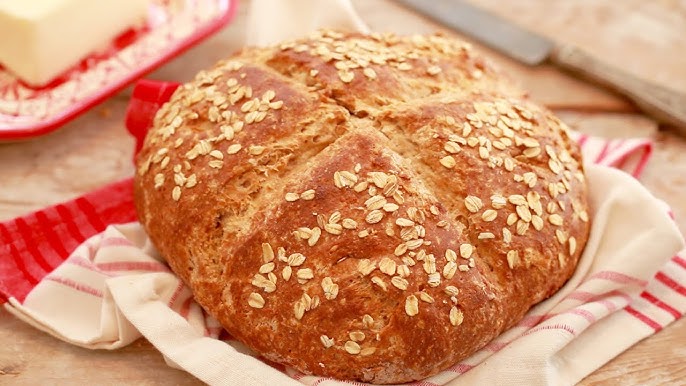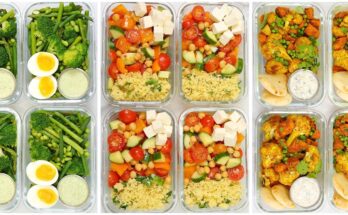Soda Bread Recipe: Soda bread is a rustic, hearty bread with deep roots in Irish tradition. It dates back to the 19th century when simple ingredients and quick preparation methods were essential for everyday life. This iconic bread stands out for its unique leavening process, relying on baking soda and buttermilk rather than yeast.
One of the greatest things about soda bread is how easy it is to make. There’s no need for fancy equipment, lengthy proofing, or even prior baking experience. In just under an hour, you can enjoy a warm, freshly baked loaf that pairs perfectly with sweet or savory dishes.
Ready to dive in? Let’s get started!
Ingredients Needed for Soda Bread
To make traditional soda bread, you’ll need just a handful of pantry staples. Here’s what you’ll need:
- 4 cups of all-purpose flour (or substitute half with whole-wheat flour for a heartier texture)
- 1 teaspoon of baking soda (this acts as the leavening agent)
- 1 teaspoon of salt
- 1 ¾ cups of buttermilk (key for activating the baking soda)
Optional Ingredients:
- A tablespoon of sugar for a slightly sweet loaf
- Add-ins like raisins, dried cranberries, or caraway seeds for extra flavor
These ingredients come together beautifully to create a dense yet tender loaf with a delightful crust.
Essential Tools and Equipment
Before you begin, gather the following tools:
- Mixing bowls: One for dry ingredients and another for wet.
- Measuring cups and spoons: Precision is key to achieving the perfect loaf.
- A baking sheet or cast-iron skillet: A sturdy surface ensures even baking.
- Sharp knife: For scoring the cross on top of the loaf.
You’re all set! Now, let’s move on to the step-by-step process.
How to Make Soda Bread – Step by Step Guide
Step 1: Preheat Your Oven and Prepare the Baking Surface
Preheating the oven is the first step to success. Set your oven to 425°F (220°C), giving it ample time to reach the desired temperature. While it’s heating, prepare your baking tray or skillet by lightly dusting it with flour or lining it with parchment paper. This prevents sticking and creates a crisp bottom crust.
Step 2: Mix the Dry Ingredients
In a large mixing bowl, combine the flour, baking soda, and salt. Sifting the flour ensures there are no lumps and helps evenly distribute the baking soda. This step is crucial for achieving a uniform rise. Once sifted, gently whisk the ingredients to ensure everything is well incorporated.
Step 3: Add Wet Ingredients
Gradually pour the buttermilk into the bowl of dry ingredients. Use a wooden spoon or your hands to mix. The key here is to combine until just moistened—you’re aiming for a shaggy, slightly sticky dough. Overmixing can make the bread tough, so keep it light!
Step 4: Knead the Dough Gently
Turn the dough onto a lightly floured surface and knead it gently for about a minute. Unlike traditional yeast bread, soda bread dough requires minimal kneading—just enough to bring it together into a cohesive ball. Too much handling will activate the gluten, leading to a dense loaf.
Step 5: Shape the Dough
Shape the dough into a round loaf and place it on your prepared baking surface. Using a sharp knife, score a deep cross on the top of the dough. This iconic cut isn’t just decorative—it allows the bread to expand evenly as it bakes.
Step 6: Bake Your Soda Bread
Place the dough into the preheated oven and bake for 30-35 minutes. The loaf should develop a golden-brown crust, and when tapped on the bottom, it will sound hollow. This is the telltale sign that your soda bread is perfectly baked.
Tips for Perfect Soda Bread
- Don’t overwork the dough: The less you handle it, the better the texture.
- Use fresh baking soda: Expired soda may result in a flat loaf.
- Adjust for altitude: Reduce baking soda slightly if you live at high altitudes.
Variations of Soda Bread
One of the best things about soda bread is its versatility. Here are a few popular variations to try:
- Whole-Wheat Soda Bread:
Swap half or all of the all-purpose flour with whole-wheat flour for a nuttier, denser loaf. You can also add a tablespoon of honey for a touch of sweetness. - Sweetened Soda Bread:
Add sugar, raisins, dried cranberries, or currants to the dough to create a sweeter bread that’s perfect for breakfast or tea. - Vegan Soda Bread:
Replace buttermilk with a mixture of plant-based milk (like almond or soy) and lemon juice or vinegar. Let it sit for 5-10 minutes to curdle before adding it to the dry ingredients.
Feel free to experiment with herbs, seeds, or grated cheese to suit your taste!
Serving and Pairing Ideas
Freshly baked soda bread is incredibly versatile when it comes to serving. Here are some ideas:
- Traditional Pairing: Serve it warm with a generous spread of butter and a drizzle of honey or jam.
- With Soups and Stews: Soda bread’s dense texture makes it perfect for soaking up hearty soups, stews, or chowders.
- Breakfast or Snack: Toast slices and top them with avocado, cream cheese, or a fried egg for a filling meal.
The slightly tangy flavor complements both sweet and savory dishes, making it a true crowd-pleaser.
Storing Soda Bread
Soda bread is best enjoyed fresh, but if you have leftovers, here’s how to store it:
- Room Temperature: Wrap the bread tightly in a clean kitchen towel and store it in an airtight container. It will stay fresh for up to 2 days.
- Refrigeration: For longer storage, place it in a plastic bag or airtight container and refrigerate for up to 5 days.
- Freezing: Slice the bread, wrap each slice individually in plastic wrap, and place them in a freezer bag. This way, you can thaw only what you need. Soda bread freezes well for up to 3 months.
Reheat leftover bread in the oven for a few minutes to restore its crisp crust.
Common Mistakes to Avoid
- Overkneading the Dough: Unlike yeast bread, soda bread requires minimal kneading. Too much handling can make it tough.
- Skipping the Cross Cut: Forgetting to score the dough can lead to uneven baking.
- Incorrect Oven Temperature: Always preheat the oven to ensure even cooking and a proper rise.
- Old Baking Soda: Baking soda loses its potency over time. Make sure it’s fresh to ensure your bread rises properly.
Health Benefits of Soda Bread
Soda bread isn’t just quick and easy—it also has some notable health perks:
- Fewer Preservatives: Homemade soda bread is free of additives and preservatives found in store-bought breads.
- Rich in Fiber: Using whole-wheat flour boosts the fiber content, aiding digestion and keeping you full longer.
- Low Sugar Content: Soda bread is naturally low in sugar, making it a healthier option for those watching their intake.
For an even healthier version, incorporate seeds like flaxseed or chia seeds for added omega-3s and nutrients.
FAQs about Soda Bread Recipe
What is soda bread?
Soda bread is a traditional quick bread that uses baking soda as a leavening agent instead of yeast. This results in a faster and easier bread-making process. It’s popular in Ireland and has variations in other cultures as well.
What ingredients are needed for soda bread?
The basic ingredients for traditional soda bread include flour, baking soda, salt, and buttermilk. Some recipes might include additional ingredients like sugar, butter, eggs, or raisins to enhance the flavor and texture.
Can I make soda bread without buttermilk?
Yes, if you don’t have buttermilk, you can make a substitute by adding a tablespoon of lemon juice or white vinegar to a cup of milk and letting it sit for about 10 minutes. This mixture can be used as a replacement for buttermilk in your soda bread recipe.
How long does it take to bake soda bread?
Soda bread typically takes about 30 to 40 minutes to bake at 375°F (190°C). The bread is done when it has a golden-brown crust and sounds hollow when tapped on the bottom.
Can soda bread be made gluten-free?
Yes, to make gluten-free soda bread, you can use gluten-free all-purpose flour. Be sure to check that the other ingredients you use are also gluten-free and consider adding xanthan gum if your flour blend doesn’t include it to help with the texture.
Is soda bread healthy?
Soda bread can be a healthy addition to your diet when made with whole grain flours and minimal sugar. It’s a good source of carbohydrates and, depending on your additions, can provide fiber and other nutrients.
How should I store soda bread?
Soda bread is best enjoyed fresh but can be stored wrapped in a clean cloth inside a bread bin for up to 2-3 days. You can also wrap it in foil and freeze it for longer storage.
Can I add other ingredients to my soda bread recipe?
Absolutely! Many variations include additions like nuts, seeds, dried fruit, or herbs to modify the flavor and texture of the bread. Experimenting with different ingredients can personalize the bread to your taste preferences.
Conclusion
Soda bread is a timeless recipe that brings together simplicity, flavor, and tradition. Whether you’re baking it for the first time or adding your own twist to the classic recipe, this bread is bound to become a staple in your kitchen. Its quick preparation, versatility, and hearty texture make it a perfect companion to any meal. So, grab your ingredients and give it a try—you won’t regret it!



